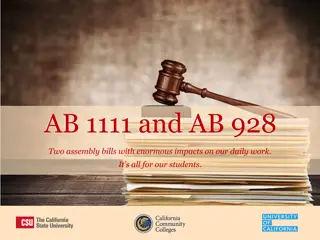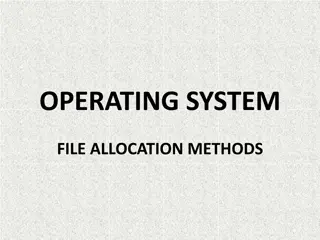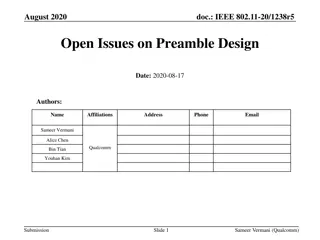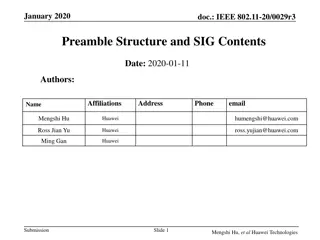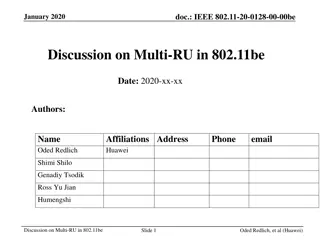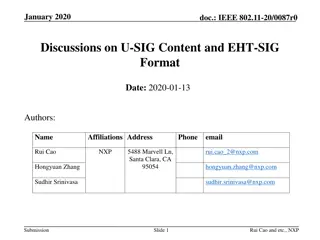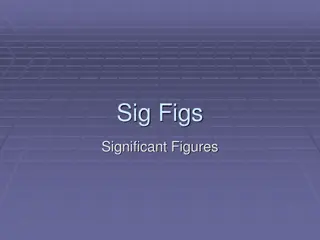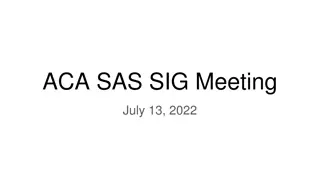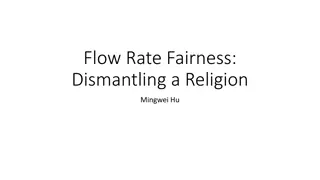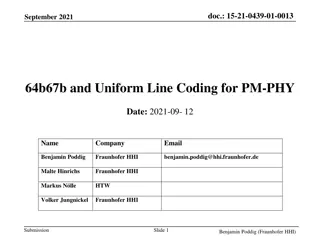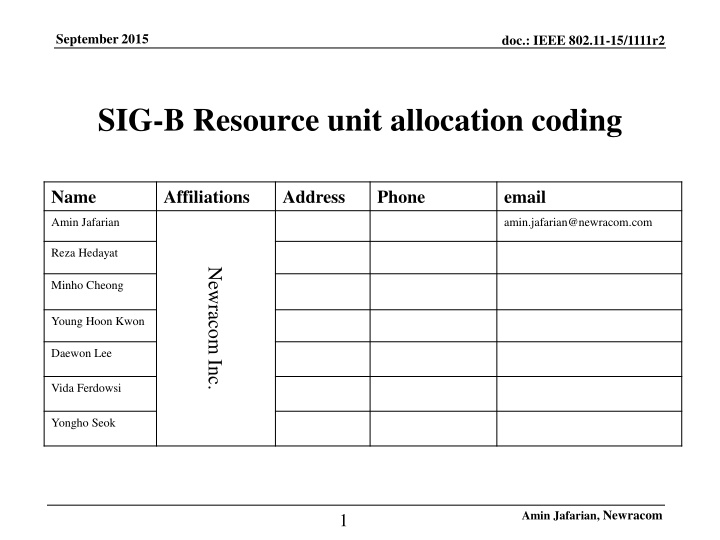
Resource Unit Allocation Schemes Comparison in IEEE 802.11-15/1111r2
Explore the comparison between fixed length and flexible length allocation schemes for resource units in IEEE 802.11-15/1111r2, focusing on SIG-B field considerations. The discussion covers the advantages and drawbacks of each approach, providing insights into optimizing bandwidth allocation in scenarios with multiple STAs.
Download Presentation

Please find below an Image/Link to download the presentation.
The content on the website is provided AS IS for your information and personal use only. It may not be sold, licensed, or shared on other websites without obtaining consent from the author. If you encounter any issues during the download, it is possible that the publisher has removed the file from their server.
You are allowed to download the files provided on this website for personal or commercial use, subject to the condition that they are used lawfully. All files are the property of their respective owners.
The content on the website is provided AS IS for your information and personal use only. It may not be sold, licensed, or shared on other websites without obtaining consent from the author.
E N D
Presentation Transcript
September 2015 doc.: IEEE 802.11-15/1111r2 SIG-B Resource unit allocation coding Name Affiliations Address Phone email Amin Jafarian amin.jafarian@newracom.com Reza Hedayat Newracom Inc. Minho Cheong Young Hoon Kwon Daewon Lee Vida Ferdowsi Yongho Seok Amin Jafarian, Newracom 1
September 2015 doc.: IEEE 802.11-15/1111r2 Motivation For UL-MU MIMO scheduling, the bandwidth allocation should be done in SIG-B field of the triggering frame In general, there are many sub-bandwidths to be allocated We need to make sure this field to stays reasonably short when there are multiple STAs allocated In this presentation we go over general concepts of two schemes and compare their performances. For simplicity, we call them with the following short names: Fixed length The length of the allocation is constant and is not a function of number of STAs or the allocated BWs Flexible length The length of the allocation is not constant and changes based on the number of STAs and the allocated BWs Amin Jafarian, Newracom 2
September 2015 doc.: IEEE 802.11-15/1111r2 Fixed length allocation For each 8MHz sub-band (4x2MHz) of 20MHz, there are total of 1 (no STA) + 7 (1 STA) + 11 (2 STAs) + 6 (3 STAs) + 1 (4 STAs) = 26 ways that can be presented with 5 bits, we also need 1 bit to represent the allocation of the middle 4MHz This means for 20MHz BW, we need 5+1+5=11 bits and for 40MHz, we need 2*11=22 bits to convey all the possible sub-band allocations Pros: Length of SIG-B depends only on the BW of the allocation and not number of STAs or the locations of the allocation Cons: It can be very long Variable length can result in shorter SIG-B in many scenario Amin Jafarian, Newracom 3
September 2015 doc.: IEEE 802.11-15/1111r2 Flexible length Its not as easy to put some figure in Flexible length encoding. It highly depends on the encoding scheme 20MHz 1 1 1 We took a simple encoding algorithm to show some comparison of the schemes. We call it Tree encoding: STA2 8MHz 8MHz 4MHz STA1 1 1 0 0 8MHZ 4MHz 2MHz 2MHz 4MHz 4MHz STA4 4MHz 4MHz STA 3 No STA 4MHz STA4 STA2 STA1 1 1100 1110 00 0 0 1 0 2MHz2MHz 2MHz STA3 2MHz 2MHz 2MHz 2MHz 2MHz Amin Jafarian, Newracom 4
September 2015 doc.: IEEE 802.11-15/1111r2 Comparing the fixed length and flexible min/max length Here is the comparison, when there are 4 STAs in the allocation: 4 STA, 40MHZ 4 STA, 80MHz 4 STA, 160MHz Fixed Length (bits) 2+5*4=22 4+5*8=44 8+5*16=88 Flexible Length maximum (bits) 2+6+4*4=24 4+6+4*6=34 8+6+4*8=46 Flexible Length minimum (bits) 1+4+6=11 11+2=13 13+2=15 Amin Jafarian, Newracom 5
September 2015 doc.: IEEE 802.11-15/1111r2 Average Flexible length Comparison Number of STAs Compress Method 20Mhz 40Mhz 80Mhz 160Mhz Fixed Flexible Fixed Flexible Fixed Flexible Fixed Flexible Fixed Flexible Fixed Flexible Fixed Flexible Fixed Flexible Fixed Flexible 10.00 5.47 10.00 8.87 10.00 11.11 10.00 12.59 10.00 13.45 10.00 13.86 10.00 14.00 10.00 14.00 0.00 0.00 20.00 7.29 20.00 12.14 20.00 15.90 20.00 18.98 20.00 21.52 20.00 23.61 20.00 25.30 20.00 26.66 20.00 27.72 40.00 9.17 40.00 15.52 40.00 20.80 40.00 25.38 40.00 29.43 40.00 33.05 40.00 36.32 40.00 39.27 40.00 41.96 80.00 11.10 80.00 19.05 80.00 25.89 80.00 32.01 80.00 37.57 80.00 42.70 80.00 47.47 80.00 51.93 80.00 56.12 1 2 3 4 5 6 7 8 9 Amin Jafarian, Newracom 6
September 2015 doc.: IEEE 802.11-15/1111r2 Flexible Length Note: In the Average scenario, we consider all cases, many of those may not be out of interest. Looking into only practical cases, the average length for flexible case is even less Pros: It reduces the length of SIG-B in many scenarios Cons: Its length depens on: Number of STAs in the allocation BW and location of STAs Amin Jafarian, Newracom 7
September 2015 doc.: IEEE 802.11-15/1111r2 Summary Two ways of encoding BW allocation inside the SIG-B is presented Fixed length and flexible length We provide one specific flexible length coding (tree encoding) and compare min/max and average performance of that with the fixed length encoding In general, the flexible length performs much better than the fixed length Amin Jafarian, Newracom 8
September 2015 doc.: IEEE 802.11-15/1111r2 Straw Poll Do you support to have an empty resource units? Do you to include the indication of the empty resource unit in the common resource part of Sig-B? Amin Jafarian, Newracom 9

